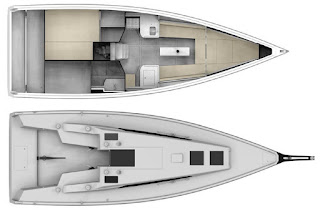
More than a
lovely boat the GS34 is for Grand Soleil a return to its origins. They are now
making more and more expensive boats, luxury fast boats and luxury main market
cruisers but their origins lay on small and not very expensive cruiser racers,
fast boats that were used for racing and cruising.
Grand
Soleil success history started 45 years ago with a 34ft boat designed by Finot,
a great little boat, good on the racing field and on the cruising grounds. It was
not made only in Italy but also in Japan (under license) and more than 300
boats were built during 11 years.
The new
GS34 aims to be a modern version of the same concept: “The project is aimed at
owners who love fun, sportive cruising and offshore racing, and was inspired by
the open ocean boats. Great attention was put in the design and naval
architecture process in order to create an offshore racing boat that is easy to
sail at maximum performance but at the same time a very comfortable fast
cruiser”.
When they
talk about the GS34 being inspired by open racing boats we would think of other
fast boats that come directly from that line of development, namely Pogo, the
ones that are truly inspired by that concept, but this hull is very different
sharing with those boats mostly the transom design, with all the beam pulled
back, but that happens with many other types of racing boats, for instance the
TP52, that would be a better reference in what regards inspiration.
Just to
make clear to you the difference, a Pogo 30 has 3.7m beam, a Pogo 36 has 4m and
the GS 34 has a beam of only 3.6m. The hull is close to the one of a JPK 1080
or a Sunfast 3600, not close to the ones of open solo racers (like Pogo is).
This is a
very different type of hull and while Pogos are maximized for downwind sailing
this one, like the Sunfast or the JPK , is a much more balanced boat in what
regards the upwind/downwind compromise. This is a boat that aims to win the
Transquadra but also one that will be successful on the Middle sea race, on the
Fastnet or even on the Sydney Hobart (like the JPK 1080 was) and that will be
competitive on traditional coastal regattas.

It is also
a boat that being able to perform well while racing is also a nice boat for
cruising, having a modern and very nice interior, much better than the one on
the Sunfast. It is as good as the one of JPK even if with a more contemporary
design, a very nice design, I would say.
Regarding
this size, the JPK 1080 is the best performing sailing boat with this type of
hulls (in what regards racing). So let’s compare it with the GS 34 to see the
similarities and the differences (first the dimensions from the JPK, in meters
and kg) ): LOA – 10.80/10.70; LWL Beam – 3.64/3.60; Draft – 2.20/2.18; B/D
(with same type of keel) – 45.3%/44.9%; Displacement – 4750/4900; Sail area
upwind – 73/ 71; Sail area downwind – 160/150.
Two very
similar sailboats, the JPK being slightly more powerful. The JPK is designed by
a very experienced and successful French designer, Jacques Valer an autodidact
that designs all JPK. Valer designs have won almost everything that there was
to be won. The GS 34 is designed by a team (Skyros), fresh from Spezia, the
Italian School of naval design (Genova) with limited but innovative design
experience, mainly on a Mini racer.
Nice to see a big company betting on an
innovative but inexperienced team composed by very young NAs, some of them very
good sailors! I really hope this design turns out really well on the racing
field. New blood on boat design is always a desirable thing.


The two have IRC maximized keels, meaning lead keels without a bulb and both can have,
if the client wishes so, torpedo keels. It is sad that the IRC still gives
advantage to less efficient keels while this is already solved on ORC rating, where
torpedo keels are the norm.
The GS34
looks just great and I believe it will be a success, or not, mostly depending
on the price. In regarding fast cruising there would not be any significant difference between the two boats, except in what regards the interior, that have a different style.
Regarding
prices I suppose, that like on JPK, they will vary hugely depending whether the
boat is intended to race on top races (and win) or if it is just a fast
cruising version or something in-between. A JPK can go from a bit over 164 000
euro to close to 300 000, depending on sail wardrobe and equipment. A basic GS
34 would cost about 139 000 euro, all prices without VAT.
That price
is about the same as for instance the one of an Oceanis 38 and it shows why main market cruiser boats
are built the way they are, including a very basic sail hardware: If they would
be built like these two, they would cost a fortune.

It explains also why Beneteau has finished (at least for now) with the First line that was on the origin of its proper existence: the built is too expensive for a boat with a considerable share of the market.
There are not enough cruisers liking sportive sailing while cruising to generate a decent profit for a boat built in large numbers, the racing market is too small and has the competition of faster small series boats. A pity! Praise to Hanse, the only one among the big mass production builders that maintain a line of fast cruisers, the Dehler line…even if I doubt that for much longer (I hope not).







